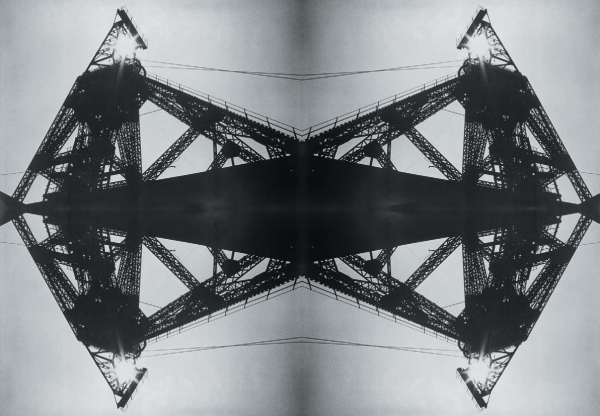Fitzrovia Noir in association with South Tyneside Council and The Customs House presents PENDULUM
‘…as I continued to step cautiously onward, there came thronging
upon my recollection a thousand vague rumours of the horrors of
Toledo. Of the dungeons there had been strange things narrated –
fables I had always deemed them – but yet strange, and to ghastly
to repeat, save in a whisper. Was I left to perish of starvation in this
subterranean world of darkness; or what fate perhaps even more
fearful awaited me ?’
Edgar Allan Poe
 Image_Polyptych (Boldon Colliery 1982/2010) © Garry Hunter
Image_Polyptych (Boldon Colliery 1982/2010) © Garry Hunter
Heritage Open Days 2010
event with contemporary
art installation at the former
St Hilda’s pithead, South
Shields NE33, featuring the
work of eight international
artists responding to the
passage of time within the
themes of subterrania and
the heritage of industrial art.
Exhibition opening times_
Thursday 9 September 2010
11am – 3pm
Friday 10 September 2010
11am – 2pm & 4pm – 7pm
Saturday 11 September 2010
11am – 4pm
http://www.fitzrovianoir.wordpress.com
Featured artists include_
Graham Carrick_Tunnel Visions
Garry Hunter_Sheaver
Peter Mackertich_Shaft triptych
Michael Mayhew_Vent series
John Perivolaris_Toledo
Manuel Sanmartin_The Underground Creature
Lucietta Williams_Sleepwalkers
David Snoo Wilson_Sub series
Fitzrovia Noir have assembled a carefully chosen selection of contemporary art that looks at local heritage and global themes of subterranean industry, exhibited at the St Hildas pithead, a stones throw from the River Tyne, a conduit to the cosmopolitan outlook of South Shields.
Two locally-born artists, painter Graham Carrick and photographer Garry Hunter have specially produced work for this exhibition, exploring both of their own father’s work at coalmines that references the famous tradition of ‘banner art’ created for Miner’s Lodges, still prevalent at galas. Carrick’s painting took on a whole new meaning when he recently discovered an archive of his family’s involvement with the coal industry, which has fed into his piece Tunnel Visions. Hunter has looked at strands of his ancestry from the Durham area, his father’s role as a crane driver at Boldon Colliery and his two grandfathers who were face workers at coalmines in the North East. By taking NUM driving manual illustrations, photographs he took when Boldon was closing in 1982 and other archive images, he has blended industrial heritage and his father’s army conscription in Germany, taking a colour infra-red image of open cast coalmining in that country with a set of ‘emergency stop’ keys . The multi-armed god Shiva is brought to mind is when looking at the emphasised commands for crane movements, that include the cross-section of a wire rope that would travel through a ‘sheave’ .
Lucietta Williams and Manuel Sanmartin look at actual and mythical inhabitants of underground worlds in their paintings, where Williams’ represents the pit ponies that lived permanently below
and Sanmartin creates an idea of an ancient animal whose bones may still exist, but the outward appearance of which is unproven. His Latin American heritage has particular poignancy at this time, with the trapped Chilean miners reminding us that working conditions for many are still hazardous.
David Snoo Wilson has utilised the art of welding to make a homage to The Kursk, that links the shipbuilding tradition of Tyneside to a famous disaster of the Russian Navy. While constructing these sub pieces, Wilson was involved in an explosion caused by residue left on the inside of
an empty gas bottle, resulting in hospitalisation – but he is now thankfully recovered and back working on this series, which now has a chilling link to the accident at St Hildas in 1839, where 51 miners were killed in a gas explosion.
Photographers Peter Mackertich and John Perivolaris have roots in Armenia and Greece respectively, but here they look at subterrania in Western Europe. Mackertich’s trio of pithead architectural studies spans from South Central France to the Black Country of England and
takes in a tower facing the North Sea, while Perivolaris’ image of a wall in the Spanish city of Toledo, reminds us of Edgar Allen Poe’s The Pit and The Pendulum, a timeless piece set in
times of the Inquisition, but has resonance with any desperate situation of being trapped in the dark underground.
Michael Mayhew’s Vent series has decorated mannequins that look at the fragile human condition, susceptible to the many dangers that lurk in confined spaces. Kill to Breathe communicates the tightness of breath felt when oxygen intake is low; Bioman the delicate structure of the human body, so susceptible when exposed to hazards within industry and the earth itself, whether dangers of electrification or radioactive poisoning.

About this entry
You’re currently reading “Fitzrovia Noir in association with South Tyneside Council and The Customs House presents PENDULUM,” an entry on Fitzrovia Noir
- Published:
- August 27, 2010 / 7:56 pm
- Category:
- Architecture, art, artist, body, building, culture, demolition, exhibition, gallery, private view, Uncategorized
- Tags:
- mining



No comments yet
Jump to comment form | comment rss [?] | trackback uri [?]